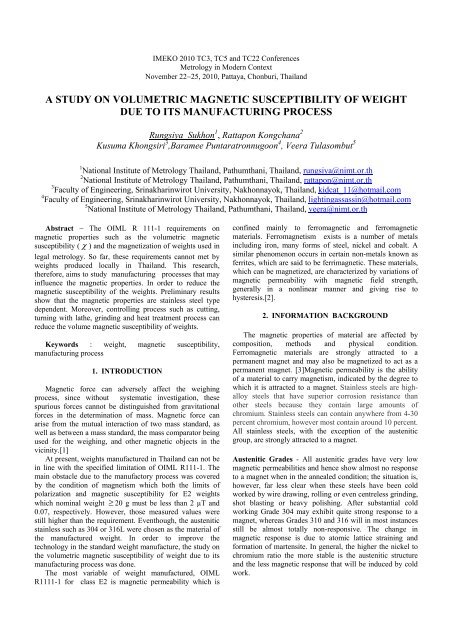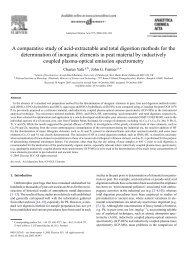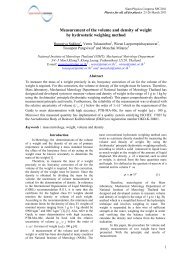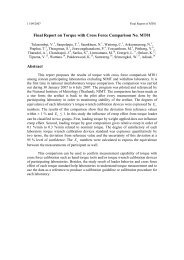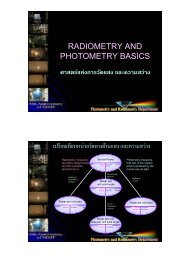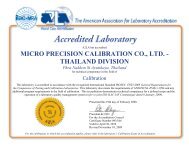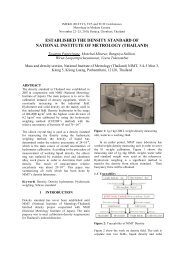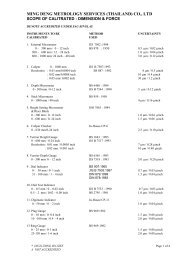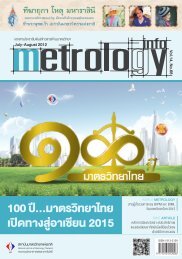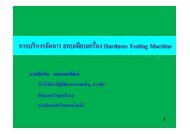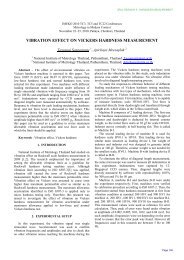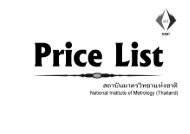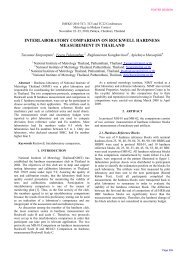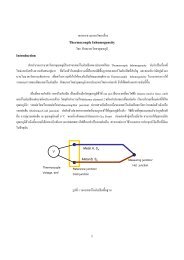a study on volumetric magnetic susceptibility of weight due to its ...
a study on volumetric magnetic susceptibility of weight due to its ...
a study on volumetric magnetic susceptibility of weight due to its ...
Create successful ePaper yourself
Turn your PDF publications into a flip-book with our unique Google optimized e-Paper software.
IMEKO 2010 TC3, TC5 and TC22 C<strong>on</strong>ferencesMetrology in Modern C<strong>on</strong>textNovember 22−25, 2010, Pattaya, Ch<strong>on</strong>buri, ThailandA STUDY ON VOLUMETRIC MAGNETIC SUSCEPTIBILITY OF WEIGHTDUE TO ITS MANUFACTURING PROCESSRungsiya Sukh<strong>on</strong> 1 , Rattap<strong>on</strong> K<strong>on</strong>gchana 2Kusuma Kh<strong>on</strong>gsiri 3 ,Baramee Puntaratr<strong>on</strong>nugo<strong>on</strong> 4 , Veera Tulasombut 51 Nati<strong>on</strong>al Institute <strong>of</strong> Metrology Thailand, Pathumthani, Thailand, rungsiya@nimt.or.th2 Nati<strong>on</strong>al Institute <strong>of</strong> Metrology Thailand, Pathumthani, Thailand, rattap<strong>on</strong>@nimt.or.th3 Faculty <strong>of</strong> Engineering, Srinakharinwirot University, Nakh<strong>on</strong>nayok, Thailand, kidcat_11@hotmail.com4 Faculty <strong>of</strong> Engineering, Srinakharinwirot University, Nakh<strong>on</strong>nayok, Thailand, lightingassassin@hotmail.com5 Nati<strong>on</strong>al Institute <strong>of</strong> Metrology Thailand, Pathumthani, Thailand, veera@nimt.or.thAbstract − The OIML R 111-1 requirements <strong>on</strong><strong>magnetic</strong> properties such as the <strong>volumetric</strong> <strong>magnetic</strong><strong>susceptibility</strong> ( χ ) and the magnetizati<strong>on</strong> <strong>of</strong> <strong>weight</strong>s used inlegal metrology. So far, these requirements cannot met by<strong>weight</strong>s produced locally in Thailand. This research,therefore, aims <strong>to</strong> <str<strong>on</strong>g>study</str<strong>on</strong>g> manufacturing processes that mayinfluence the <strong>magnetic</strong> properties. In order <strong>to</strong> reduce the<strong>magnetic</strong> <strong>susceptibility</strong> <strong>of</strong> the <strong>weight</strong>s. Preliminary resultsshow that the <strong>magnetic</strong> properties are stainless steel typedependent. Moreover, c<strong>on</strong>trolling process such as cutting,turning with lathe, grinding and heat treatment process canreduce the volume <strong>magnetic</strong> <strong>susceptibility</strong> <strong>of</strong> <strong>weight</strong>s.Keywords : <strong>weight</strong>, <strong>magnetic</strong> <strong>susceptibility</strong>,manufacturing process1. INTRODUCTIONMagnetic force can adversely affect the weighingprocess, since without systematic investigati<strong>on</strong>, thesespurious forces cannot be distinguished from gravitati<strong>on</strong>alforces in the determinati<strong>on</strong> <strong>of</strong> mass. Magnetic force canarise from the mutual interacti<strong>on</strong> <strong>of</strong> two mass standard, aswell as between a mass standard, the mass compara<strong>to</strong>r beingused for the weighing, and other <strong>magnetic</strong> objects in thevicinity.[1]At present, <strong>weight</strong>s manufactured in Thailand can not bein line with the specified limitati<strong>on</strong> <strong>of</strong> OIML R111-1. Themain obstacle <strong>due</strong> <strong>to</strong> the manufac<strong>to</strong>ry process was coveredby the c<strong>on</strong>diti<strong>on</strong> <strong>of</strong> magnetism which both the lim<strong>its</strong> <strong>of</strong>polarizati<strong>on</strong> and <strong>magnetic</strong> <strong>susceptibility</strong> for E2 <strong>weight</strong>swhich nominal <strong>weight</strong> ≥ 20 g must be less than 2 µT and0.07, respectively. However, those measured values werestill higher than the requirement. Eventhough, the austeniticstainless such as 304 or 316L were chosen as the material <strong>of</strong>the manufactured <strong>weight</strong>. In order <strong>to</strong> improve thetechnology in the standard <strong>weight</strong> manufacture, the <str<strong>on</strong>g>study</str<strong>on</strong>g> <strong>on</strong>the <strong>volumetric</strong> <strong>magnetic</strong> <strong>susceptibility</strong> <strong>of</strong> <strong>weight</strong> <strong>due</strong> <strong>to</strong> <strong>its</strong>manufacturing process was d<strong>on</strong>e.The most variable <strong>of</strong> <strong>weight</strong> manufactured, OIMLR1111-1 for class E2 is <strong>magnetic</strong> permeability which isc<strong>on</strong>fined mainly <strong>to</strong> ferro<strong>magnetic</strong> and ferro<strong>magnetic</strong>materials. Ferromagnetism exists is a number <strong>of</strong> metalsincluding ir<strong>on</strong>, many forms <strong>of</strong> steel, nickel and cobalt. Asimilar phenomen<strong>on</strong> occurs in certain n<strong>on</strong>-metals known asferrites, which are said <strong>to</strong> be ferri<strong>magnetic</strong>. These materials,which can be magnetized, are characterized by variati<strong>on</strong>s <strong>of</strong><strong>magnetic</strong> permeability with <strong>magnetic</strong> field strength,generally in a n<strong>on</strong>linear manner and giving rise <strong>to</strong>hysteresis.[2].2. INFORMATION BACKGROUNDThe <strong>magnetic</strong> properties <strong>of</strong> material are affected bycompositi<strong>on</strong>, methods and physical c<strong>on</strong>diti<strong>on</strong>.Ferro<strong>magnetic</strong> materials are str<strong>on</strong>gly attracted <strong>to</strong> apermanent magnet and may also be magnetized <strong>to</strong> act as apermanent magnet. [3]Magnetic permeability is the ability<strong>of</strong> a material <strong>to</strong> carry magnetism, indicated by the degree <strong>to</strong>which it is attracted <strong>to</strong> a magnet. Stainless steels are highalloysteels that have superior corrosi<strong>on</strong> resistance thanother steels because they c<strong>on</strong>tain large amounts <strong>of</strong>chromium. Stainless steels can c<strong>on</strong>tain anywhere from 4-30percent chromium, however most c<strong>on</strong>tain around 10 percent.All stainless steels, with the excepti<strong>on</strong> <strong>of</strong> the austeniticgroup, are str<strong>on</strong>gly attracted <strong>to</strong> a magnet.Austenitic Grades - All austenitic grades have very low<strong>magnetic</strong> permeabilities and hence show almost no resp<strong>on</strong>se<strong>to</strong> a magnet when in the annealed c<strong>on</strong>diti<strong>on</strong>; the situati<strong>on</strong> is,however, far less clear when these steels have been coldworked by wire drawing, rolling or even centreless grinding,shot blasting or heavy polishing. After substantial coldworking Grade 304 may exhibit quite str<strong>on</strong>g resp<strong>on</strong>se <strong>to</strong> amagnet, whereas Grades 310 and 316 will in most instancesstill be almost <strong>to</strong>tally n<strong>on</strong>-resp<strong>on</strong>sive. The change in<strong>magnetic</strong> resp<strong>on</strong>se is <strong>due</strong> <strong>to</strong> a<strong>to</strong>mic lattice straining andformati<strong>on</strong> <strong>of</strong> martensite. In general, the higher the nickel <strong>to</strong>chromium ratio the more stable is the austenitic structureand the less <strong>magnetic</strong> resp<strong>on</strong>se that will be induced by coldwork.
Stress Relieving - Any austenitic stainless steel which hasdeveloped <strong>magnetic</strong> resp<strong>on</strong>se <strong>due</strong> <strong>to</strong> cold work can bereturned <strong>to</strong> a n<strong>on</strong>-<strong>magnetic</strong> c<strong>on</strong>diti<strong>on</strong> by stress relieving. Ingeneral this can be readily achieved by briefly heating <strong>to</strong>approximately 700 - 800°C (this can be c<strong>on</strong>veniently carriedout by careful use <strong>of</strong> an oxy-acetylene <strong>to</strong>rch). However,unless the steel is a stabilised grade it could becomesensitised <strong>to</strong> carbide precipitati<strong>on</strong>. Full soluti<strong>on</strong> treatment at1000 - 1150°C will remove all <strong>magnetic</strong> resp<strong>on</strong>se withoutdanger <strong>of</strong> reduced corrosi<strong>on</strong> resistance <strong>due</strong> <strong>to</strong> carbides. If<strong>magnetic</strong> permeability is a fac<strong>to</strong>r <strong>of</strong> design or isincorporated in<strong>to</strong> a specificati<strong>on</strong>, this should be clearlyindicated when purchasing the stainless steel from asupplier.Cold Working - Many cold drawn and/or polished artefact,<strong>weight</strong>, have a noticeable amount <strong>of</strong> magnetism as a result<strong>of</strong> the previous cold work. This is particularly the case withgrades 304 and 303, and much less so for the higher nickelgrades such as 310 and 316. Even within the chemicallimitati<strong>on</strong>s <strong>of</strong> a single standard analysis range there can be apr<strong>on</strong>ounced variati<strong>on</strong> in the rate <strong>of</strong> inducement <strong>of</strong> <strong>magnetic</strong>resp<strong>on</strong>se from cold work.Effect <strong>of</strong> cold work <strong>on</strong>- austenitic stainless steelsThe table1. shows the relative permeability <strong>of</strong> 304 and 316at a low <strong>magnetic</strong> field strength and various cold reducti<strong>on</strong>s.Highly alloyed austenitics including the high nitrogengrades do not develop low carb<strong>on</strong> martensite <strong>on</strong> cold workand so their relative permeability typically remains below1.02. The values may be compared with mild or carb<strong>on</strong> steelwhich has a ferritic structure and a relative permeability <strong>of</strong>at least 200. The effect <strong>of</strong> compositi<strong>on</strong> and degree <strong>of</strong> coldwork (measured by the tensile strength) <strong>on</strong> the permeability,and hence the strength <strong>of</strong> any <strong>magnetic</strong> attracti<strong>on</strong>, is plottedbelow fig below for a series <strong>of</strong> austenitic alloys. It showsthat increasing the nickel c<strong>on</strong>tent reduces the effect <strong>of</strong> coldwork <strong>on</strong> <strong>magnetic</strong> properties, shows as Fig.1 below[3].Table 1. Relati<strong>on</strong> <strong>of</strong> relative permeability <strong>of</strong> 304 and 316 at alow <strong>magnetic</strong> field strength and various cold reducti<strong>on</strong>s.Alloy304(Chromium 19%,nickel 10.7%)316(Chromium 17.5%,nickel 13.4%,molybdenum 2.4%)Cold reducti<strong>on</strong>(% reducti<strong>on</strong> inarea)RelativePermeability0 1.003713.8 1.004832.0 1.037165.0 1.54084.5 2.200 1.00320.8 1.00345.0 1.00460.8 1.006581.0 1.00703. EXPERIMENT AND RESULTSFirstly, we c<strong>on</strong>sidered about the comp<strong>on</strong>ent <strong>of</strong> material.So, the OIML <strong>weight</strong> class E2 was analysed the compoundby Optical Emissi<strong>on</strong> Spectrometer. The result shows in table2.Table 2. The element compound <strong>of</strong> OIML <strong>weight</strong> class E2 inpercent <strong>of</strong> <strong>to</strong>tal <strong>weight</strong>ElementWeight in %compoundC 0.010Si 0.496Mn 0.167P 0.019S 0.004Ni 25.512Cr 20.436Mo 3.266Cu 1.085Mo 3.266Ti 0.008Nb 0.014This result shows the largest element compound <strong>of</strong>OIML <strong>weight</strong> class E2 is Nickel (Ni) and close up thespecificati<strong>on</strong> <strong>of</strong> stainless type SUS 809L[4]. Unfortunately,we can not find this type stainless steel in commercialThailand. Next step, the type and price <strong>of</strong> stainless steel inlocal are pick up, shows in table 3.Table 3. The price each type <strong>of</strong> stainless steel in Baht*(φ2.5 cm. X 6 m.)Type 904L 310S 304 316L 303price 41,910 11,500 5,900 9,000 8,500(*about 31 Baht = 1USD)Therefore, the Fig.2 shows the austenitic stainless suchas 304 and 316L were chosen as the material <strong>of</strong> themanufactured <strong>weight</strong>.
The results measurement <strong>of</strong> comparing the volume<strong>magnetic</strong> suscepability at maximum <strong>magnetic</strong> field is788.25 A.m -1 before and after process <strong>of</strong> cutting, turningwith lathe for both type stainless shows in table 4 below.Table 4. The results <strong>of</strong> volume <strong>magnetic</strong> suscepabilityat maximum <strong>magnetic</strong> field is 788.25 A.m -1Fig.2 shows the rod <strong>of</strong> austenitic stainless 304 and 316LThen, Cutting both rod and mark point <strong>of</strong> each pieceswith the c<strong>on</strong>trol process with fix the feed at 224cycle/minute, compare with cooling water, as Fig.3 andexcept cooling water, as Fig.4Type316L304Process cuttingand turning withlatheC<strong>on</strong>diti<strong>on</strong> S/NCoolingwaterexceptCoolingwaterexceptVolume <strong>magnetic</strong> suscepabilityat Maximum <strong>magnetic</strong> field = 788.25 A.m -1BeforeprocessAfterprocess%Deviati<strong>on</strong>A10 0.101 0.125 23.76 3.6A11 0.119 0.170 42.86 6.4A12 0.117 0.156 33.33 5.0A13 0.100 0.128 28.00 4.2A14 0.089 0.108 21.35 3.2% UncertaintyU c (k=2)A15 0.089 0.110 23.60 3.5B10 0.109 0.124 13.76 2.1B11 0.119 0.161 35.29 5.3B12 0.122 0.142 16.39 2.5B13 0.129 0.157 21.71 3.3B14 0.117 0.156 33.33 5.0B15 0.100 0.175 75.00 11.3Regarding <strong>to</strong> the <strong>to</strong>oling machine maintenance andresults from table4 , so our team decide <strong>to</strong> use cooling waterin fix the c<strong>on</strong>diti<strong>on</strong> process shows as Fig.5.Fig.3 shows cutting process with cooling waterFig.4 shows cutting process without cooling waterThe <strong>magnetic</strong> properties results use the BIPMsuscep<strong>to</strong>meter that was set up at NIMT mass labora<strong>to</strong>ry formeasurement <strong>of</strong> Volume <strong>magnetic</strong> <strong>susceptibility</strong> <strong>on</strong> thesesample. Regarding <strong>to</strong> the theory, measurement procedureand uncertainty calculati<strong>on</strong> from [1] and [5]. The masscompara<strong>to</strong>r is Mettler Toledo UMT5 with a capacity 5.1 gand readability 0.1 µg. The rare-earth magnet is material <strong>of</strong>Nd Fe and B, diameter 4.8 mm, height 5.1 mm, <strong>magnetic</strong>moment 0.085 Am 2 and relative <strong>magnetic</strong> permeability is1.00506 at 99.97 kA/m <strong>of</strong> <strong>magnetic</strong> field strength.Fig.5 shows using cooling waterNext, <str<strong>on</strong>g>study</str<strong>on</strong>g>ing about heat treatment process attemperature 768, 850 and 1100 o C shows as Fig 6 and s<strong>to</strong>p hotby dipping water shows as Fig 7. The results shows in table5.Then, the final adjust <strong>weight</strong> by polishing process is pick up<strong>to</strong> <str<strong>on</strong>g>study</str<strong>on</strong>g> for improvement the manufacturing process <strong>of</strong><strong>weight</strong> shows as Fig 8 and the results <strong>of</strong> volume <strong>magnetic</strong>suscepability in table 6.
Fig.6 shows heat treatment processFig.8 shows polishing processTable 6. The results <strong>of</strong> volume <strong>magnetic</strong> suscepabilitybefore and after final polishing processType316L304Volume <strong>magnetic</strong> suscepabilityat Maximum <strong>magnetic</strong> field = 788.25 A.m -1S/NBefore After % % Uncertaintyprocess process deviati<strong>on</strong> U c (k=2)A10 0.125 0.106 -15.20 2.3A11 0.170 0.124 -27.06 4.1A12 0.156 0.113 -27.56 4.1B10 0.124 0.118 -4.84 0.7B11 0.161 0.128 -20.50 3.1B12 0.142 0.101 -28.87 4.3Type316L304Fig.7 shows dipping water <strong>to</strong> s<strong>to</strong>p hotTable 5. The results <strong>of</strong> volume <strong>magnetic</strong> suscepabilitybefore and after the heat treatment processHeat treatmentprocessTemperature( o C)76885011007688501100Volume <strong>magnetic</strong> suscepability atMaximum <strong>magnetic</strong> field = 788.25 A.m -1S/N Before After %deviati<strong>on</strong>% U c(k=2)A7 0.105 0.060 -42.86 6.4A8 0.083 0.043 -48.19 7.2A9 0.104 0.060 -42.31 6.3A1 0.100 0.044 -56.00 8.4A2 0.085 0.043 -49.41 7.4A3 0.104 0.040 -61.54 9.2A4 0.094 0.176 87.23 13.1A5 0.099 0.170 71.72 10.8A6 0.094 0.173 84.04 12.6B7 0.143 0.068 -52.45 7.9B8 0.101 0.058 -42.57 6.4B9 0.138 0.064 -53.62 8.0B1 0.100 0.047 -53.00 8.0B2 0.097 0.046 -52.58 7.9B3 0.106 0.046 -56.60 8.5B4 0.094 0.172 82.98 12.4B5 0.096 0.164 70.83 10.6B6 0.091 0.152 67.03 10.14. CONCLUSIONSThe process <strong>of</strong> manufacturing <strong>weight</strong> in Thailand mayinfluence the <strong>magnetic</strong> properties. In order <strong>to</strong> reduce the<strong>magnetic</strong> <strong>susceptibility</strong> <strong>of</strong> the <strong>weight</strong>s <strong>to</strong> meet OIMLR111-1 technical requirement about magnetism.Preliminary results show that the <strong>magnetic</strong> properties arestainless steel type dependent. The results <strong>of</strong> comparis<strong>on</strong>between 304 and 316 austenitic stainless steels show thethe volume <strong>magnetic</strong> suscepability change during themanufacturing process such as cutting, turning with lathe,grinding and heat treatment process.REFERENCES[1] OIML R 111-1 : Internati<strong>on</strong>al Recommendati<strong>on</strong>Weights <strong>of</strong> classes E1, E2, F1, F2, M1, M1-2, M2, M2-3 and M3 Part 1 ; Metrological and Technicalrequirements requirements , pp.33, 2004.[2] Jack Blitz, Electrical and Magnetic Methods <strong>of</strong>N<strong>on</strong>destructive Testing, Adam Hilger, New York, pp35-37 1991.[3] Australian Stainless Steel Development Associati<strong>on</strong>ACN 061 226 051 Website www.assda.asn.au[4] Report <strong>of</strong> support technology development projects <strong>of</strong>the Thai industry , NIMT, Office <strong>of</strong> Nati<strong>on</strong>al Scienceand Technology (ITAP) and Thai Scale companyLimited, 2009.[5] R. Davis and M. Glaser, “Magnetic properties <strong>of</strong><strong>weight</strong>s, their measurements and <strong>magnetic</strong> interacti<strong>on</strong>sbetween <strong>weight</strong>s and balances”, Metrologia, vol. 40,nº. 3, pp. 339-355, December 2003.


